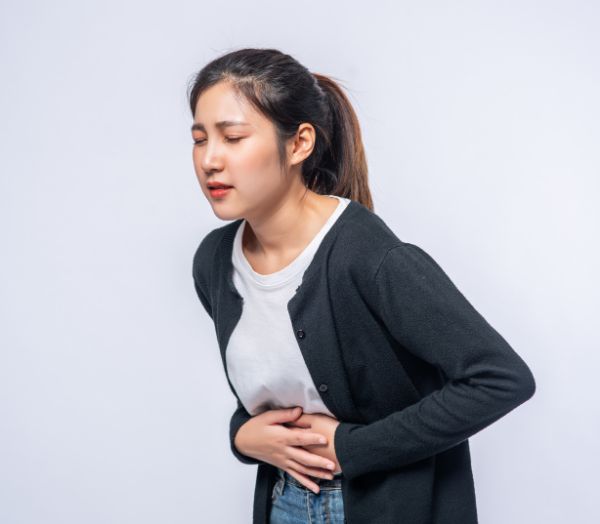No products in the cart.

Understanding Endometriosis- From Symptoms to Solutions
Endometriosis is an inflammatory condition where there is a proliferation in the endometrial-like tissue of the uterus. The growth and contraction of this lining depends on female hormones, especially estrogen which causes pain depending on the location of the tissue. According to 2023 data, the prevalence of endometriosis globally in women and girls is 10%.
Following are the symptoms that may indicate the presence of endometriosis:
- Dysmenorrhea (severe and frequent menstrual cramps)
- Nausea and bloating
- Digestives disturbances
- Severe pelvic pain
- Urinary symptoms (blood in urine or burning sensation during urination)
- Occasional anxiety and other psychological issues.
With these symptoms, there is definite disturbance of quality of life, relationships and mental health. Sometimes endometriosis affects the fertility of women. Along with these, there might be other complications which, if left untreated, can have long term consequences, and hence there is a need to understand this condition better.
Etiology and stages of Endometriosis
The etiology of this condition is not very clear and multifaceted but there are a lot of reasons and theories that are speculated. Most common factor seems to be inflammation, angiogenesis (formation of blood vessels from pre-existing blood vessels), retrograde menstruation (wherein the menstrual blood with endometrial cells flows back to fallopian tube), resistance to cell death, and malfunctioning of immune system and oxidative stress.
There are 4 stages of endometriosis, I—minimal, II—mild, III—moderate, and IV—severe. These are differentiated with the location of the tissue formation but do not correlate to the pelvic pain that is experienced.
Risk factors
Here are a few risk factors associated with endometriosis:
- Early menarche or getting the first menstrual cycle (in girls <12 years).
- Shorter cycle of periods (< 26 days).
- Excessive blood flow during periods resulting in significant nutrient
deficiencies. - Lean body size or underweight.
- Poor quality of life.
Diagnosis of Endometriosis
General diagnosis starts with understanding the menstrual symptoms and pelvic pain. Although many screening tools are suggested, none are validated to identify or specify the condition. But to understand and rule out other medical conditions, ultrasonography or MRI scans are used. Laparoscopy study is used as the gold standard as they show apparent lesions (any damaged tissue). If needed, biopsy is
also taken.
Management of endometriosis
There is no specific cure for endometriosis but since endometriosis is multifaceted, the management is also multidisciplinary. It may involve pharmacological (with drugs and hormone medicine like GnRH-analogues and contraceptives for pain management), non- pharmacological (acupuncture, physiotherapy) and surgical methods if necessary.
The following image shows the multidisciplinary care for endometriosis.

Image source from research paper- Lukáč, Štefan & Hancke, Katharina & Janni, Wolfgang & Pfister, Kerstin & Schäffler, Henning & Schmid, Marinus & Ebner, Florian & Kloss, Tabea & Dayan, Davut. (2023). Three‐dimensional model for improvement of endometriosis care (3D‐E). International Journal of Gynecology & Obstetrics.
Nutrition Intervention
While other interventions are important to manage endometriosis, right nutrition plays a crucial role and it’s important to have a balanced diet. However, there are a few key nutrients which have a role in the management of endometriosis and are listed below.
- Vitamin C and E: Both the vitamins have antioxidant properties which may help with reduction in the growth of lesions and improvement in fertility of ovaries. Vitamin C is present in citrus fruits, bell peppers, broccoli, amla etc. and vitamin E is present in nuts and seeds, oils, green leafy vegs.
- Vitamin D: People with endometriosis may have significant reduction in vitamin D levels and if they are already vitamin D deficient, this may in turn cause pelvic pain. So, for those, vitamin D might be helpful. The major source is sunlight and some food sources include egg yolks, fatty fish, cod liver oil. Supplementation may be necessary for those who have very low values.
- Resveratrol and Quercetin: They both have anti-inflammatory properties. In a study done for 12-14 weeks on 34 patients with supplementation of resveratrol (400 mg) found to have reduced biomarkers. Resveratrol is present in red grapes, berries and nuts and quercetin is found in onion, chillies, cauliflower, lettuce etc.
- Zinc: With endometriosis, zinc levels may decrease, so adding zinc rich foods might be beneficial as zinc plays an important role in the body’s metabolism. They are found in nuts, seeds, whole grains, meat and fish.
- Omega 3 fatty acids: Generally, omega 3 fatty acids are known to help in reducing inflammation, so it might be helpful in case of endometriosis as well. They are mainly found in fish, nuts and oil seeds.
- Other macro and micro elements are also important, as deficiency of those may also cause symptoms of endometriosis.
There are also extensive studies going on to understand the role of probiotics in reducing the symptoms. Since the symptoms of endometriosis overlap with other medical conditions, it is crucial to meet a doctor for the right diagnosis and get your nutrition intake personalized appropriately. With this understanding, it is possible to manage endometriosis effectively.
Image attribution: Image by jcomp on Freepik

Senior Dietitian
M.Sc FNS (AN)



